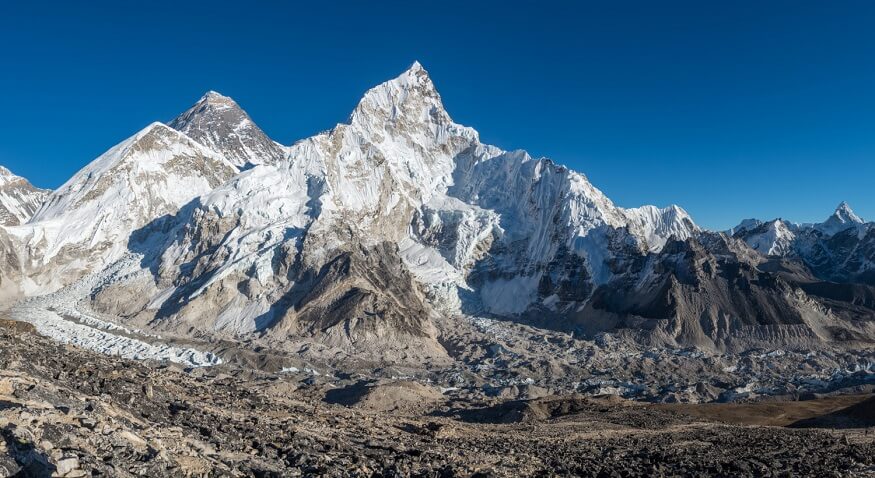While we might work hard to move those Metaphorical Mountains in our lives, there’s no denying the exquisite beauty of the Real Kind.
That being said, our knowledge of Mountains is limited. We delight in knowing the answer to questions like ‘Which is the tallest mountain in the world?’ Oh, and in case you didn’t already know, it is Mount Everest!
It’s little wonder that the word ‘Mountain’ is used as a metaphor for achieving a gargantuan feat against all odds.
While we all know what Mountains look like, it might well be prudent to ask, ’What Is A mountain?’
What Mountains Are
According to the Dictionary, a mountain is ‘That which is higher and steeper than a hill.’ Simply put, it is a landform that rises high above the surrounding terrain in a limited area.
Mountains are made from rocks and earth, and are generally higher than 600 metres. Those that are less than 600 metres, are called Hills. Mountains usually have steep, sloping sides and slightly rounded peaks. Some mountains have trees growing along their sides and at the summit of some mountains, there is snow.
Types of Mountains
Now that we have the answer to the question ‘What is a Mountain?’, here’s a look at the types of mountains.
Fold Mountains
These are the most common kinds of mountains found on Earth. The following are key characteristics of Fold Mountains.
- They are formed when two or more Tectonic Plates collide with each other.
- They are created through a process of Orogeny that spans millions of years.
- The plates push each other with such force, that the rocks and boundaries fold, thereby giving rise to the mountains we know well.
Examples: The Himalayas in Asia, The Alps in Europe
Fault Block Mountains
Once again, these mountains are a direct result of the movement of those tectonic plates.
- Fractures in the Earth’s crust push rocks upwards and downwards.
- Instead of the Earth’s crust ‘folding’, it ‘fractures.’ The faults that result can move blocks upwards or downwards.
- The movement of the Earth’s crust along these faults, can often cause an earthquake in the adjacent areas.
Examples: The Harz Mountains (Germany), the Sierra Nevada Mountains (North America.)
Dome Mountains
Unlike the preceding two mountain types, this one does not result from the movement of tectonic plates.
- When Magma under the earth pushes its way to the surface, it pushes different layers upwards.
- In time, the magma cools and forms rocks. The resultant elevation is called a ‘Vault’, or ‘Dome.’
- When the high-rising domes are eroded by wind and water, they form several dome-shaped peaks called Dome Mountains.
Examples: The Weald (South England), The Black Hills (South Dakota).
Volcanic Mountains
We all know what volcanoes are, but do we have any idea how Volcanic Mountains are formed?
- Rocks and lava pile up, layer by layer. After they have cooled down, they form structures called Volcanic Mountains.
- That ‘Crater’ in Volcanic Mountains, is a circular depression that is formed when Lava forcefully erupts to the surface.
Examples: Mount St. Helens (North America), Pico Teide (the Canary Islands.)
Fun Facts about Mountains for Kids
Now that we have seen how mountains are formed, it’s time to take a peek into the vault of interesting mountain facts.
After scrolling through these fun facts, you can rest assured that your kids will have some cool Mountain Questions to ask their friends. Questions beyond the more obvious ‘Which is the tallest mountain in the world?’
- Mauna Kea (Hawaii) is a whopping 10,000 metres tall. However, only 4207 metres of these are found above sea level. The rest of the mountain is underwater!
- In the year 2005, a couple decided to get married atop a mountain peak. This was the first wedding to take place on a mountain.
- In the year 1953, two people officially became the first people to climb to the top of the highest mountain in the world, Mount Everest. They were Edmund Hillary and Tenzing Norgay.
- There have been thousands of people who have managed to scale Mount Everest. However, only one of them has been a mere 13 years old.
- The mountain that is touted as the most difficult to climb, is K2, that is on the Pakistan-China border. Its nickname is ‘Savage Mountain’, as it is only possible to climb it using specific routes.
- It is believed that the Mountain Goat is more adept at climbing mountains than the most skilled mountaineers. This animal, which is indigenous to North America, has cloven hooves and toes that allows it to cover wide steps.
- In the year1974, a German Mountain climbing team set out to climb the mountain Annapurna 4. In a twist of fate, they ended up reaching the top of Annapurna 2 by mistake.
- The Matterhorn might appear to be a single peak, but it is actually two rocks joined together to form one. Both its North and South Face offer stunning views and unique climbing challenges.
- Before the existence of GPS, geographers measured the heights of mountain peaks through a method called Triangulation. This essentially involved measuring the mountain peaks from different observation points.
- The most mountainous countries in the world are Bolivia and Nepal. In some of the cities there, some tourists have a perpetual headache on account of the low air pressure.
- Mount Everest is no match for the highest mountain in the known universe, which is almost three times as tall. It is Olympus Mons, a giant volcano that is found on Mars.
- A whopping fifth of land on the Earth’s surface, is believed to be mountainous terrain. Besides covering much of the Earth’s surface, mountains serve as home to up to 10 percent of its population.
- Some of the peaks of mountains appear as islands.
We at EuroKids believe that you should encourage your children to learn as much as they possibly can, about the natural wonders of our planet. This includes Mountains. The next time you plan a family vacation, you might want to select a Mountain-Based Destination!











